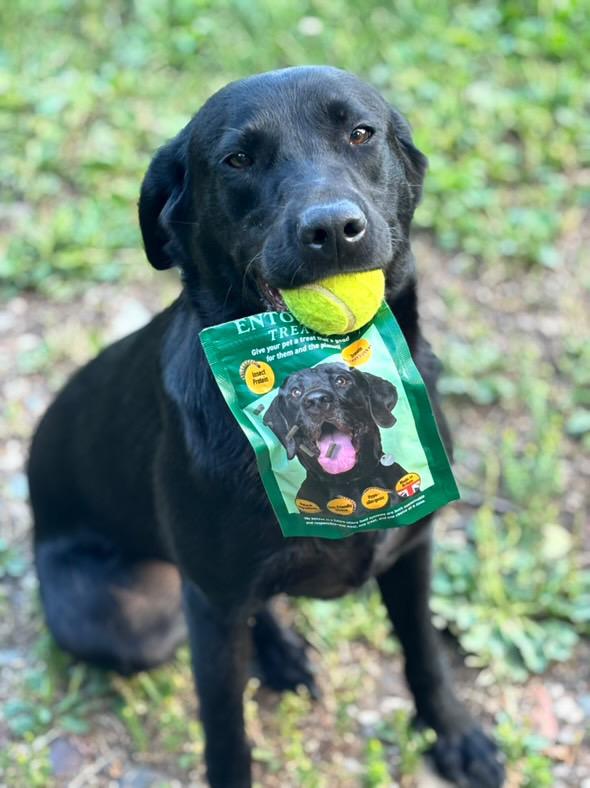
6 Surprising Benefits of Using Treats for Dog Training (And Why They Really Work)
Share
It all started with a walk and an idea.
Two cousins, frustrated by confusing pet food labels and unhealthy treat options, began wondering why it was so difficult to find a dog treat that was both nutritionally clean and environmentally responsible. Their dogs deserved better. The planet deserved better. That simple stroll turned into a mission to revolutionise pet nutrition… Entovore was born.
But what made this mission stick wasn't just the ingredients (like British-farmed mealworms) or the zero-waste supply chain. It was understanding how dogs learn and how to make training easier, more effective, and more enjoyable for everyone involved. The secret? Treats.
Let’s dig into six surprising benefits of using treats to train your dog and why they might just be your most powerful tool.
1. Treats Build Positive Associations
At its core, treat-based training is built on positive reinforcement. Every time your dog sits, stays, or comes when called, giving a small, tasty reward reinforces that behavior. It’s science-backed: your dog learns that doing the right thing leads to good outcomes. This not only speeds up the learning process but also replaces old-school punishment methods that can damage trust and cause stress.
Pro tip: Always pair a treat with verbal praise or a clicker cue so your dog begins to associate both with success!
2. Motivation that Sticks (Even in Distracting Environments)
Let’s face it, your dog would probably rather sniff another dog’s derriere than “sit” on command in the middle of the park. This is where high-value treats shine. They capture your dog’s attention and keep it focused on you, not the hundreds of distractions around them.
Pro tip: Reserve your highest-value treats (like cold-pressed mealworm bites) for your most challenging commands or environments.
3. Strengthens Your Bond
Training with treats is about more than commands, it’s a bonding exercise. When your dog looks to you for rewards, listens for cues, and trusts you to deliver, you're building a stronger relationship based on mutual understanding, not fear or domination.
Pro tip: Over time, your dog begins to see training time as quality time, which is exactly what it should be.
4. Great for Teaching New Behaviours
Need to teach your dog to “lie down”? Use a treat as a lure. Want to reinforce “leave it” or recall? A fast-delivered reward seals the deal.
Treats help guide dogs into the desired behavior and lock in that muscle memory. Once the movement becomes familiar, you can fade the treat and switch to praise, toys, or other forms of reward.
Pro tip: Always fade lures into prompts to avoid treat-dependency.
5. Increases Focus and Repetition
Training is all about repetition. Using treats allows for multiple, quick-fire rounds of practice without fatigue or frustration. This is especially helpful when introducing a new skill or when practicing obedience in a class setting.
Pro tip: Studies show that short, frequent training bursts (5–10 minutes a day) are far more effective than longer, inconsistent sessions.
6. Solves Specific Behavioural Challenges
From fear of being left alone to leash reactivity, treats are essential in managing more complex behavioral issues. High-reward treats create positive associations that can help shift a dog’s mindset from fear or anxiety to trust and calm.
Pro tip: Rewarding calm behavior e.g. while you grab your keys can help a dog with separation anxiety start to relax before you leave.
Why Treat-Based Training Really Works
Treats work because they’re tied to the science of how dogs learn, through “operant conditioning” (thanks, B.F. Skinner!). When a behavior is followed by a positive consequence (like a tasty treat), it becomes more likely to occur again. It’s not bribery, it’s effective, evidence-based reinforcement.
This is especially true for food-driven breeds (we’re looking at you, Labradors) who thrive on consistency, reward, and engagement.
How to Use Treats Wisely
✔ Choose healthy treats that are small, low-calorie, and easy to chew (like Entovore's pea-sized bites).
✔ Avoid overfeeding. Keep treats to under 10% of your dog’s daily caloric intake.
✔ Use them to lure, then prompt. Once your dog understands the behavior, fade out the food as a lure.
✔ Always reward the behavior, not before. This helps avoid using food as a bribe.
✔ Incorporate variety. Use a mix of treats, praise, toys, and play as your dog progresses.
The Bottom Line
Treat-based training is one of the simplest and most powerful tools in your dog training toolkit. It taps into your dog’s natural motivations, strengthens your bond, and accelerates learning, all while making training fun and stress-free for you both.
Whether you’re teaching sit, stay, or just trying to keep your dog from darting after a squirrel, a well-timed treat might be just the thing that turns chaos into calm.
P.S.S. Want to learn more about novel proteins (like mealworms) and how they can support your dog’s health and the planet? Check out our blog post here.
